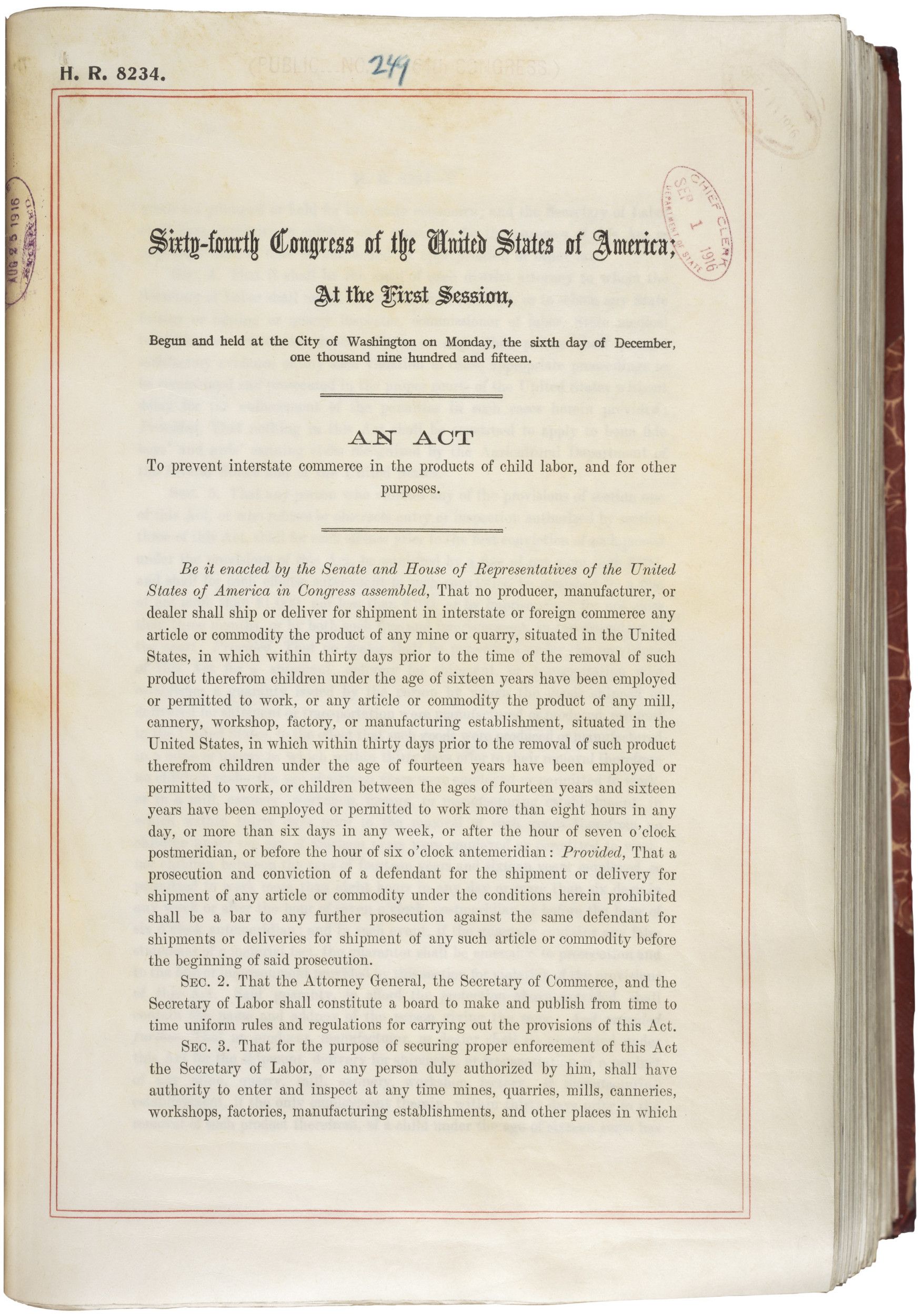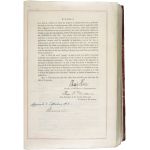Keating-Owen Child Labor Act
9/1/1916
Add to Favorites:
Add all page(s) of this document to activity:

Add only page 1 to activity:
Add only page 2 to activity:
This act limited the working hours of children and forbade the interstate sale of goods produced by child labor. The Supreme Court later ruled it unconstitutional.
The 1900 census had revealed that approximately 2 million children were working in mills, mines, fields, factories, stores, and on city streets across the United States. The census report helped spark a national movement to end child labor in the United States.
In 1908, the National Child Labor Committee hired Lewis Hine as its staff photographer and sent him across the country to photograph and report on child labor. Social reformers began to condemn child labor because of its detrimental effect on the health and welfare of children.
This act was the first child labor bill. It was based on a 1906 proposal by Senator Albert J. Beveridge and used the government's ability to regulate interstate commerce to regulate child labor. It banned the sale of products from any factory, shop, or cannery that employed children under the age of 14, from any mine that employed children under the age of 16, and from any facility that had children under the age of 16 work at night or for more than 8 hours during the day.
Although Congress passed the Keating-Owen Act and President Woodrow Wilson signed it into law, the Supreme Court ruled that it was unconstitutional in 1918 (in Hammer v. Dagenhar) because it overstepped the purpose of the government's powers to regulate interstate commerce. In its opinion, the Court said the power to regulate production and commerce were two different things.
Congress passed another child labor bill in December 1918 as part of the Revenue Act of 1919 (also called the Child Labor Tax Law), this time citing the federal government’s power to levy taxes. In 1922, the Supreme Court found it too unconstitutional (Bailey v. Drexel Furniture Company). The Court reasoned that "The power of Congress to regulate interstate commerce does not extend to curbing the power of the states to regulate local trade."
In 1924, Congress tried to regulate child labor through a constitutional amendment. The House of Representatives and Senate passed a joint resolution that was then submitted to the state legislatures for ratification. But the campaign for ratification was stalled by an effective campaign to discredit it. Opponents' charges ranged from states' rights arguments fearing increased federal power, to accusations that the amendment was a communist-inspired plot to subvert the Constitution. It fell short of the required three-fourths of states threshold needed to add it to the Constitution.
Congress finally obtained Federal protection for children in 1938, when it passed the Fair Labor Standards Act. The act prohibits "oppressive child labor" in the United States, which is defined, with exceptions, as the employment of youth under the age of 16 in any occupation or the employment of youth under 18 years old in hazardous occupations. The act was also challenged in the Supreme Court, but was upheld.
The 1900 census had revealed that approximately 2 million children were working in mills, mines, fields, factories, stores, and on city streets across the United States. The census report helped spark a national movement to end child labor in the United States.
In 1908, the National Child Labor Committee hired Lewis Hine as its staff photographer and sent him across the country to photograph and report on child labor. Social reformers began to condemn child labor because of its detrimental effect on the health and welfare of children.
This act was the first child labor bill. It was based on a 1906 proposal by Senator Albert J. Beveridge and used the government's ability to regulate interstate commerce to regulate child labor. It banned the sale of products from any factory, shop, or cannery that employed children under the age of 14, from any mine that employed children under the age of 16, and from any facility that had children under the age of 16 work at night or for more than 8 hours during the day.
Although Congress passed the Keating-Owen Act and President Woodrow Wilson signed it into law, the Supreme Court ruled that it was unconstitutional in 1918 (in Hammer v. Dagenhar) because it overstepped the purpose of the government's powers to regulate interstate commerce. In its opinion, the Court said the power to regulate production and commerce were two different things.
Congress passed another child labor bill in December 1918 as part of the Revenue Act of 1919 (also called the Child Labor Tax Law), this time citing the federal government’s power to levy taxes. In 1922, the Supreme Court found it too unconstitutional (Bailey v. Drexel Furniture Company). The Court reasoned that "The power of Congress to regulate interstate commerce does not extend to curbing the power of the states to regulate local trade."
In 1924, Congress tried to regulate child labor through a constitutional amendment. The House of Representatives and Senate passed a joint resolution that was then submitted to the state legislatures for ratification. But the campaign for ratification was stalled by an effective campaign to discredit it. Opponents' charges ranged from states' rights arguments fearing increased federal power, to accusations that the amendment was a communist-inspired plot to subvert the Constitution. It fell short of the required three-fourths of states threshold needed to add it to the Constitution.
Congress finally obtained Federal protection for children in 1938, when it passed the Fair Labor Standards Act. The act prohibits "oppressive child labor" in the United States, which is defined, with exceptions, as the employment of youth under the age of 16 in any occupation or the employment of youth under 18 years old in hazardous occupations. The act was also challenged in the Supreme Court, but was upheld.
Transcript
Sixty-fourth Congress of the United States of America; At the First Session,Begun and held at the City of Washington on Monday, the sixth day of December, one thousand nine hundred and fifteen.
AN ACT To prevent interstate commerce in the products of child labor, and for other purposes.
Be it enacted by the Senate and House of Representatives of the United States of America in Congress assembled, That no producer, manufacturer, or dealer shall ship or deliver for shipment in interstate or foreign commerce, any article or commodity the product of any mine or quarry situated in the United States, in which within thirty days prior to the time of the removal of such product therefrom children under the age of sixteen years have been employed or permitted to work, or any article or commodity the product of any mill, cannery, workshop, factory, or manufacturing establishment, situated in the United States, in which within thirty days prior to the removal of such product therefrom children under the age of fourteen years have been employed or permitted to work, or children between the ages of fourteen years and sixteen years have been employed or permitted to work more than eight hours in any day, or more than six days in any week, or after the hour of seven o'clock postmeridian, or before the hour of six o'clock antemeridian: Provided, That a prosecution and conviction of a defendant for the shipment or delivery for shipment of any article or commodity under the conditions herein prohibited shall be a bar to any further prosecution against the same defendant for shipments or deliveries for shipment of any such article or commodity before the beginning of said prosecution.
SEC. 2. That the Attorney General, the Secretary of Commerce and the Secretary of Labor shall constitute a board to make and publish from time to time uniform rules and regulations for carrying out the provisions of this Act.
SEC. 3. That for the purpose of securing proper enforcement of this Act the Secretary of Labor, or any person duly authorized by him, shall have authority to enter and inspect at any time mines quarries, mills, canneries, workshops, factories, manufacturing establishments, and other places in which
[pages omitted]
been that of a child as to whom the producer, or manufacturer has in; good faith procured, at the time of employing such child, and has since in good faith relied upon and kept on file a certificate, issued in such form, under such conditions, any by such persons as may be prescribed by the board, showing the child to be of such an age that the shipment, delivery for shipment, or transportation was not prohibited by this Act. Any person who knowingly makes a false statement or presents false evidence in or in relation to any such certificate or application therefor shall be amenable to prosecution and to the fine or imprisonment provided by this section for violations of this Act. In any State designated by the board, an employment certificate or other similar paper as to the age of the child, issued under the laws of that State and not inconsistent with the provisions of this Act, shall have the same force and effect as a certificate herein provided for.
SEC. 6. That the word “person” as used in this Act shall be construed to include any individual or corporation or the members of any partnership or other unincorporated association. The term “ship or deliver for shipment in interstate or foreign commerce” as used in this Act means to transport or to ship or deliver for shipment from any State or Territory or the District of Columbia to or through any other State or Territory or the District of Columbia or to any foreign country; and in the case of a dealer means only to transport or to ship or deliver for shipment from the State, Territory or district of manufacture or production.
SEC. 7. That this Act shall take effect from and after one year from the date of its passage.
Approved, September 1, 1916.
This primary source comes from the General Records of the United States Government.
National Archives Identifier: 5730381
Full Citation: An Act of September 1, 1916, Public Law 64-249, 39 STAT 675, to Prevent Interstate Commerce in the Products of Child Labor, and for Other Purposes [Keating-Owen Child Labor Act]; 9/1/1916; Enrolled Acts and Resolutions of Congress, 1789 - 2011; General Records of the United States Government, Record Group 11; National Archives Building, Washington, DC. [Online Version, https://docsteach.org/documents/document/keating-owen-child-labor-act, April 27, 2024]Rights: Public Domain, Free of Known Copyright Restrictions. Learn more on our privacy and legal page.





